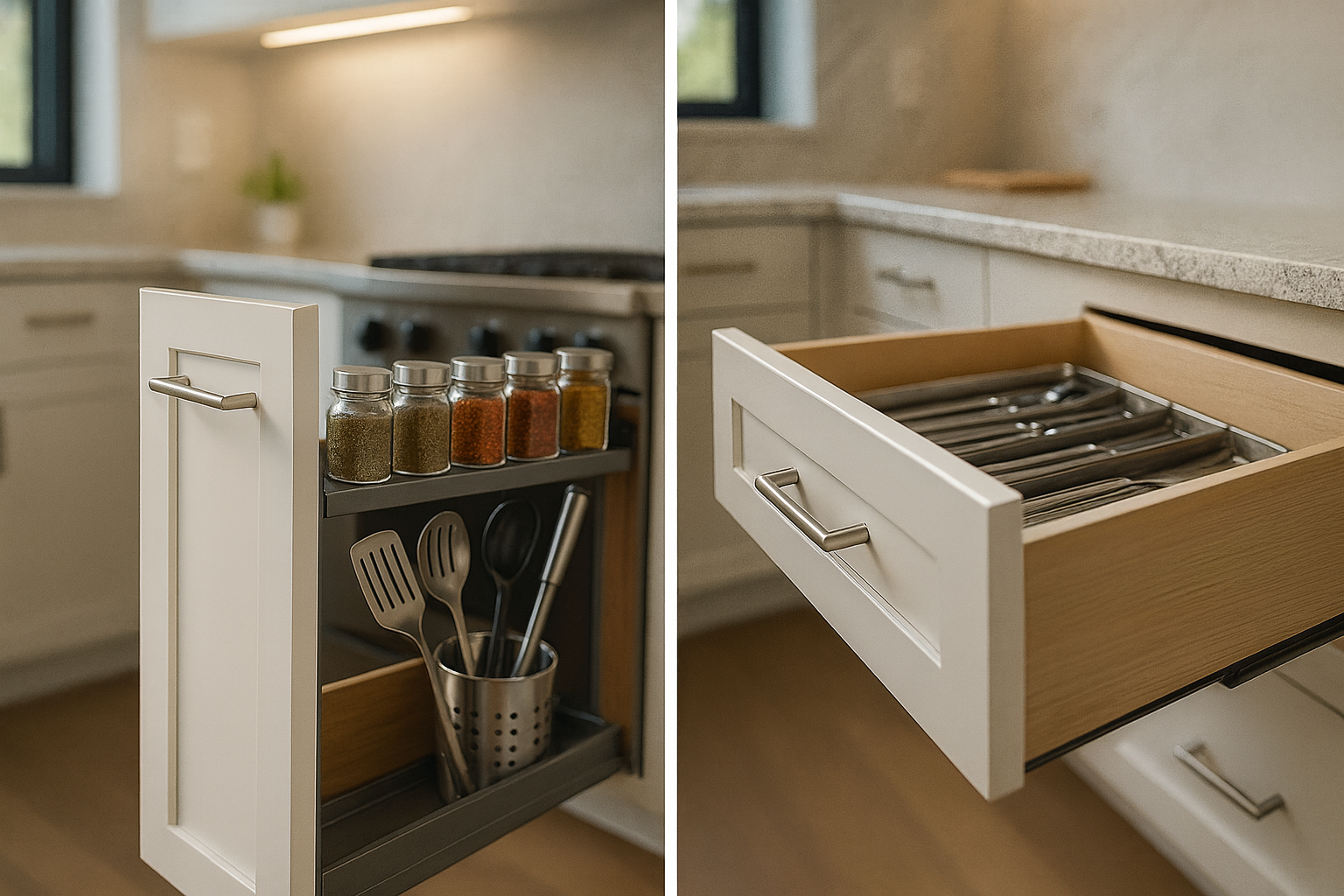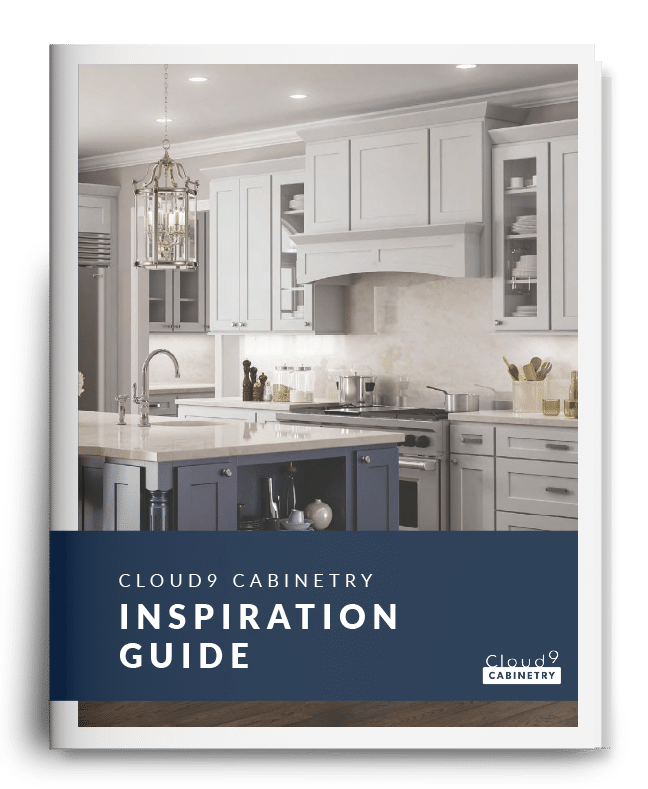Cabinet storage is not just about space—it’s about how well that space functions in daily use. If you’re planning a kitchen upgrade or exploring ways to improve your current layout, you’ve likely come across two popular storage features: pull-out shelves and drawers.
At first glance, they appear similar. Both allow you to access items without bending, reaching, or removing everything in front. But functionally, they serve slightly different purposes—and knowing which one belongs where can make the difference between a kitchen that works and one that works harder.
In this guide, we’ll clarify the difference between pull-out shelves and drawers, outline their respective pros and cons, and help you make the right decision for your cabinetry.

What’s the Difference?
The distinction lies in construction and intended use:
- Pull-out shelves are mounted inside a cabinet box, behind a door. You open the cabinet first, then slide the shelf out.
- Drawers are independent storage units with integrated faces. You pull the drawer open directly, without opening an exterior door.
Both use full-extension glides and are designed for smooth access—but they serve different organizational roles.
Benefits of Pull-Out Shelves
Pull-out shelves (also called roll-outs) are most often used in base cabinets and pantry units. They make it easier to reach items at the back of a deep shelf.
Advantages:
- Visibility: You can see the entire contents of the shelf without crouching or moving other items.
- Retrofit potential: Pull-outs can often be added to existing cabinets with minimal structural changes.
- Ideal for grouped storage: Excellent for organizing cookware, pantry goods, or small appliances behind full-height doors.
Flexible height spacing: Shelves can be adjusted or stacked depending on cabinet dimensions.
Considerations:
- Requires two motions (open the door, then pull the shelf)
- Contents may shift during motion if not organized in bins or dividers
- Less efficient for high-frequency access zones
Benefits of Drawers
Cabinet drawers are commonly found in base cabinetry and islands. Their integrated construction makes them ideal for high-use zones, such as utensil storage, cookware, or food prep tools.
Advantages:
- One-step access: No door to open—just pull the drawer and go.
- Superior compartmentalization: Dividers, knife blocks, spice trays, and utensil organizers are easier to integrate in drawer formats.
- Stronger hardware support: Drawers can often support heavier items than retrofitted pull-outs.
Better ergonomics: Ideal for homeowners seeking reduced bending, lifting, or overreaching.
Considerations:
- Typically more expensive than shelves, depending on construction
- Not all drawers are created equal—low-quality glides can limit weight capacity
Can become cluttered if not well organized

Which Should You Use—and Where?
The best layouts use both pull-out shelves and drawers, placed intentionally based on what they will store and how often they’re accessed. Here’s a guide based on use case:
Use Pull-Out Shelves for:
- Deep pantry cabinets where visual access is needed
- Storage zones behind large cabinet doors (e.g. cleaning supplies or oversized bakeware)
- Organizing dry goods in sealed bins
- Under-sink storage where pipe clearance affects shelf space
Use Drawers for:
- Everyday tools: utensils, towels, and flatware
- Heavier items: cookware, mixing bowls, or dishware
- Food prep zones with high traffic
- Hidden charging drawers or junk drawer organization
In many designs, it’s not about either/or—it’s about placing the right storage in the right place.
What About Retrofits?
If you’re working with an existing kitchen, pull-out shelves are often easier to retrofit than drawers. They install inside existing base cabinets without requiring major door modifications or face changes.
At Cloud9 Cabinetry, we frequently recommend retrofitting pull-outs in prep zones or pantry cabinets when a full remodel isn’t on the table—but we encourage new builds or major renovations to consider drawer-heavy layouts for better long-term function.
The Holiday Hosting Factor
If you’re preparing your kitchen for the fall season—or aiming to finish updates before the holidays—storage upgrades like pull-outs and drawers are among the fastest ways to improve flow and reduce stress.
- Pull-outs keep ingredients, pans, and supplies visible during prep and cleanup.
- Drawers make it easier for guests to find tools, serving utensils, or dishware without creating visual clutter.
Installing these features ahead of a hosting season lets your kitchen work more quietly and efficiently in the background—so you can focus on the occasion, not the mess.
Built-in Storage That Works
Our designers help homeowners make sense of their space—not just in square footage, but in real-life usage. Whether you’re building a new kitchen, remodeling a primary residence, or upgrading a rental, we help you:
- Choose the right combination of drawers and pull-outs
- Understand placement by work zone
- Select hardware that supports daily use without compromise
- See full-size cabinet displays and mechanisms in person
Walk in any time or bring your floor plan—we’ll help you rethink your storage from the inside out.
Frequently Asked Questions: Corner Cabinet Solutions
1. Are pull-out shelves cheaper than drawers?
Generally, yes. Pull-out shelves often cost less than full drawer construction, especially when added to existing cabinetry. However, high-end pull-out systems with soft-close hardware can narrow the price gap.
2. Can I add pull-out shelves to my current kitchen cabinets?
Yes. Pull-outs are one of the most popular retrofit upgrades and can be added to many standard base or pantry cabinets. Proper measurements and durable glides are key.
3. Which lasts longer—pull-outs or drawers?
Both can last a long time if constructed with quality hardware and materials. Drawers tend to support heavier weights more reliably, but either system should perform well under daily use when properly installed.
4. Are drawers better for organizing small items?
Yes. Drawers are easier to divide into compartments, which makes them ideal for tools, utensils, spices, and electronics. Pull-out shelves are better suited to grouped or larger items.
5. Should I use drawers instead of base cabinets?
In most modern kitchen layouts, yes. Drawers often offer better visibility, access, and organization than fixed-shelf base cab

Storage Should Work, Not Work Against You
Choosing between pull-out shelves and drawers isn’t just about cost—it’s about how you cook, clean, and live in your kitchen every day. With smart planning, both can serve different purposes—and when placed with intention, they can make your kitchen easier to navigate, faster to clean, and more enjoyable to use.
Cloud9 Cabinetry offers practical guidance and real-world options for layouts that go beyond surface aesthetics. Let’s make your kitchen feel as good as it looks—starting with how it stores what matters.

